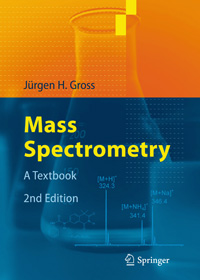
Springer
Customer Service
Haberstr. 7
69126 Heidelberg
Germany
http://www.springer.com
Mass Spectrometry – A Textbook, 2nd edition
Gross, Jürgen H.
Springer Heidelberg, February 2011, 770 pages, 552 illustrations.
Hardcover ISBN 978-3-642-10709-2
eBook e-ISBN 978-3-642-10711-5
DOI 10.1007/978-3-642-10711-5
Fully Revised and Expanded
A highly successful textbook, acclaimed for its comprehensiveness, accuracy, and its many excellent illustrations and photographs now comes in its second edition – completely revised and substantially extended.
It provides in-depth explanations of concepts, methods, and techniques. Students and professionals alike are guided step-by-step from the basics to the successful application of mass spectrometry. Starting from the very principles of gas-phase ion chemistry, isotopic composition, and accurate mass, the author leads through the design of all types of mass analyzers and ionization methods to mass spectral interpretation and coupling techniques.
The book has been expanded by more than 200 pages. No chapter has remained untouched. Numerous passages have been rewritten to improve the clarity of explanations while keeping them short and concise. Care has been taken not only to explain how, but also to why things are done a certain way. Several schemes have been added to clarify interrelationships between different techniques.
Overall, the book has been expanded by more than 200 pages. No chapter has remained untouched. Numerous passages have been rewritten to improve the clarity of explanations while keeping them short and concise. Care has been taken not only to explain how, but also to why things are done a certain way. Several schemes have been added to clarify interrelationships between different techniques.
What’s New
- The book now comprises fifteen instead of twelve chapters, each of them headed by essential “Learning Objectives”.
- Chapter 9 introduces methods of ion activation such as CID, ECD, ETD, and IRMPD closely related to the instrumental approaches to tandem mass spectrometry.
- Chapter 13 now deals with sampling and ion generation from surfaces under ambient conditions as afforded by DART and DESI.
- Finally, Chapter 15 on inorganic mass spectrometry has been added to include element speciation that bridges the gap between biomedical and trace elemental analysis and to open a perspective extending beyond the key topics of this book.
- Chapter 4 on instrumentation has been significantly expanded to cover orbitrap, linear ion traps, TOF/TOF, FT-ICR, and the ever-changing hybrid instruments including IMS-MS systems.
- More detailed attention is drawn to applications regarding biopolymers, especially in those chapters dealing with MALDI and ESI.
- Tables compiling data for general reference were transferred to the expanded appendix.